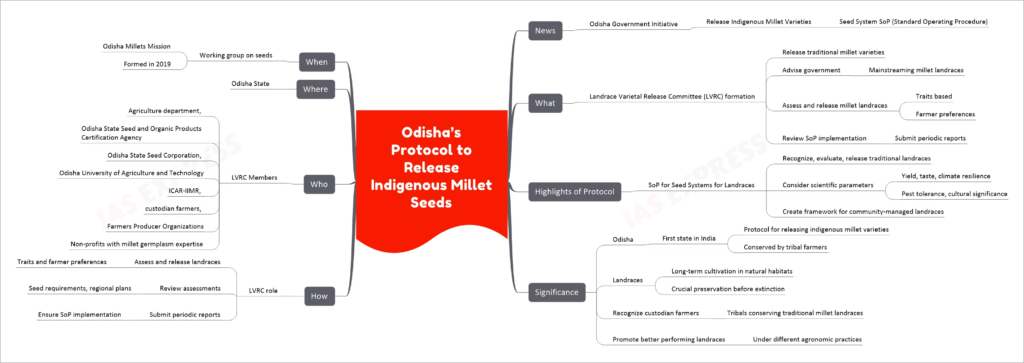Odisha’s Protocol to Release Indigenous Millet Seeds


News:
What:
- The state government has formed a committee called the Landrace Varietal Release Committee (LVRC) to release traditional millet varieties.
- The LVRC will advise the state government on mainstreaming landraces of millets in Odisha.
- The committee will assess and release landraces of millet crops based on their traits and farmer preferences.
- It will review the implementation of the government-approved Standard Operating Protocol (SoP) on landraces and submit periodic reports.
Highlights of Protocol:
- The SoP for seed systems for landraces has been developed to recognize, evaluate, and release traditional landraces.
- The protocol considers scientific parameters like yield, taste, climate resilience, pest tolerance, and cultural significance.
- It aims to create an enabling framework for landraces managed by community-based institutions.
Significance:
- Odisha becomes the first state in India to develop a protocol for releasing indigenous millet varieties conserved by tribal farmers.
- Landraces are ecotypes cultivated for a long time in their natural habitats, and their preservation is crucial before they become extinct.
- Recognizing the efforts of custodian farmers, especially tribals, in conserving traditional millet landraces.
- Promoting the use of landraces that have shown better performance than released varieties under different agronomic practices.
How:
- The LVRC will assess and release landraces based on their traits and farmer preferences.
- The committee will review assessments of landraces, seed requirements, and plan for different regions of the state.
- It will submit periodic reports to the state government, ensuring the implementation of the SoP.
Who:
- The LVRC consists of representatives from various organizations, including the Agriculture department, Odisha State Seed and Organic Products Certification Agency, Odisha State Seed Corporation, Odisha University of Agriculture and Technology, ICAR-IIMR, custodian farmers, Farmers Producer Organizations, and non-profits with expertise in millet germplasm.
Where:
- The initiative is taking place in the state of Odisha.
When:
- The working group on seeds under the Odisha Millets Mission was formed in 2019.
Glossary:
- Millet: A group of small-seeded grasses grown as food crops. They are known for their nutritional value and resilience to adverse growing conditions.
- Landrace: A locally adapted, traditional crop variety cultivated by farmers over generations.
- Standard Operating Protocol (SoP): A set of guidelines or procedures to be followed in a specific context to ensure consistency and quality.
- Ecotype: A population of a species that has adapted to a specific local environment.
- Custodian farmers: Farmers who actively conserve and maintain traditional crop varieties.
- Odisha Millets Mission (OMM): A flagship program launched in 2017-18 to revive millets comprehensively in the state of Odisha.
- Indian Council of Agricultural Research (ICAR): An autonomous organization responsible for coordinating agricultural education and research in India.
- Indian Institute of Millets Research: A research institute focused on millets and other small millets.
- Odisha University of Agriculture and Technology: A state agricultural university in Odisha, India.
- Revitalising Rainfed Agriculture Network: An organization working to improve rainfed agriculture practices and livelihoods.
- Watershed Support Services and Activity Network (WASSAN): A network working on sustainable agriculture, watershed management, and rural livelihoods.
If you like this post, please share your feedback in the comments section below so that we will upload more posts like this.

